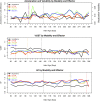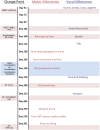Using nonlinear methods to quantify changes in infant limb movements and vocalizations
- PMID: 25161629
- PMCID: PMC4130108
- DOI: 10.3389/fpsyg.2014.00771
Using nonlinear methods to quantify changes in infant limb movements and vocalizations
Abstract
The pairing of dynamical systems theory and complexity science brings novel concepts and methods to the study of infant motor development. Accordingly, this longitudinal case study presents a new approach to characterizing the dynamics of infant limb and vocalization behaviors. A single infant's vocalizations and limb movements were recorded from 51-days to 305-days of age. On each recording day, accelerometers were placed on all four of the infant's limbs and an audio recorder was worn on the child's chest. Using nonlinear time series analysis methods, such as recurrence quantification analysis and Allan factor, we quantified changes in the stability and multiscale properties of the infant's behaviors across age as well as how these dynamics relate across modalities and effectors. We observed that particular changes in these dynamics preceded or coincided with the onset of various developmental milestones. For example, the largest changes in vocalization dynamics preceded the onset of canonical babbling. The results show that nonlinear analyses can help to understand the functional co-development of different aspects of infant behavior.
Keywords: Allan factor; infant vocalization; motor development; nonlinear methods; recurrence.
Figures



References
-
- Adolph K. E., Berger S. E. (2011). Physical and motor development, in Developmental Science: An Advanced Textbook, 6th Edn, eds Bornstein M. H., Lamb M. E. (Hillsdale, NJ: Lawrence Erlbaum Associates; ), 241–302
-
- Allan D. W. (1966). Statistics of atomic frequency standards. Proc. IEEE 54, 221–230 10.1109/PROC.1966.4634 - DOI
LinkOut - more resources
Full Text Sources
Other Literature Sources

